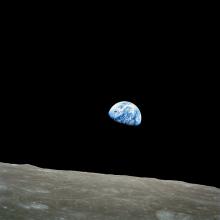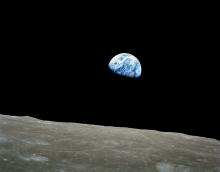Listen to today's episode of StarDate on the web the same day it airs in high-quality streaming audio without any extra ads or announcements. Choose a $8 one-month pass, or listen every day for a year for just $30.
You are here
Moon and Saturn
The Moon slides down the southwestern sky this evening. It’s accompanied by Saturn, the second-biggest planet in the solar system. Saturn looks like a bright star to the right of the Moon.
Sunlight illuminates about half of the lunar hemisphere that faces our way. In other words, the Moon is at first quarter.
It probably sounds odd that it’s both a half Moon and a quarter Moon. But the two fractions describe different things. At first quarter, the Moon is one-fourth of the way through its cycle of phases. Daylight spreads across half of the visible lunar hemisphere, making it look like a half Moon.
If you look at that “half,” you’ll see several dark splotches. Those are lunar “seas” — another term that can be a bit bewildering. They’re filled not with water, but with volcanic rock. But long-ago skywatchers thought they looked like water. So they called these features lakes, seas, or oceans.
Among those visible tonight is the Sea of Crises — a small circular spot away from the other dark areas. Three larger ones are joined together: the Sea of Serenity, Sea of Tranquility, and the Sea of Fertility.
And this is a special night for watching the Moon: International Observe the Moon Night. Many groups around the country will host Moon-watching events.
If you miss the Moon tonight, though, don’t worry about it. It’ll be in good view tomorrow night, too, and most other nights of the year — a steady and beautiful presence in the night sky.
Script by Damond Benningfield






